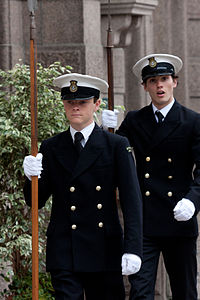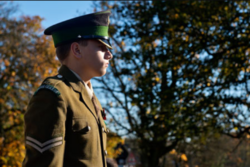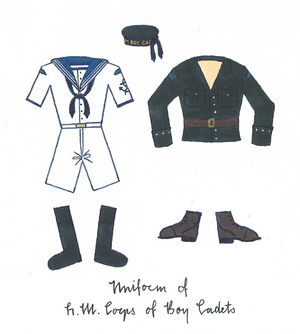King's Cadet Corps: Difference between revisions
No edit summary |
|||
| Line 12: | Line 12: | ||
| equipment = {{bulleted list|Army Division|Navy Division}} | | equipment = {{bulleted list|Army Division|Navy Division}} | ||
| equipment_label = Divisions | | equipment_label = Divisions | ||
| size = | | size = 620,888 (2019) | ||
| commander1 = [[Alexander II of Great Nortend|Alexander II]] | | commander1 = [[Alexander II of Great Nortend|Alexander II]] | ||
| commander1_label = Captain-General and Admiral | | commander1_label = Captain-General and Admiral | ||
| Line 22: | Line 22: | ||
It developed from 19th century volunteer companies of cadets raised in Erbonian independent schools as preparation for commission into the armed forces, with the support of the War Office. In the 20th century, the Board of Education raised companies out of the boys in state senior schools. In 1953, for the Golden Jubilee of Edmund IX, the Corps was formally established by Royal charter, combining the Cadet Training Force, the Sea Cadet Corps, and numerous other small youth groups who voluntarily joined up. Successive monarchs since have served as Captain-General and Admiral of Cadets. | It developed from 19th century volunteer companies of cadets raised in Erbonian independent schools as preparation for commission into the armed forces, with the support of the War Office. In the 20th century, the Board of Education raised companies out of the boys in state senior schools. In 1953, for the Golden Jubilee of Edmund IX, the Corps was formally established by Royal charter, combining the Cadet Training Force, the Sea Cadet Corps, and numerous other small youth groups who voluntarily joined up. Successive monarchs since have served as Captain-General and Admiral of Cadets. | ||
The Corps is a quasi-military organisation incorporated into the structures of the Royal Army and Navy Royal. However, it is often described as being “Scouting in a military uniform”, having incorporated much of the fledgling scout associations at its establishment. It is by far the most popular youth organisation for boys. As of the start of 2019, there are | The Corps is a quasi-military organisation incorporated into the structures of the Royal Army and Navy Royal. However, it is often described as being “Scouting in a military uniform”, having incorporated much of the fledgling scout associations at its establishment. It is by far the most popular youth organisation for boys. As of the start of 2019, there are 620,888 boys between the ages of 11 and 19 in the Corps. | ||
==Symbols== | ==Symbols== | ||
Revision as of 18:52, 9 November 2020
| His Majesty's Corps of Boy Cadets | |
|---|---|
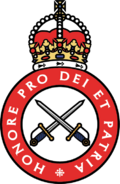 Badge of the Cadet Corps | |
| Active | June 5, 1876–present |
| Type | Patriotic youth organisation |
| Size | 620,888 (2019) |
| Headquarters | Lendert-with-Cadell, |
| Motto(s) | Honore pro Dei et patria |
| Divisions |
|
| Commanders | |
| Captain-General and Admiral | Alexander II |
| Master of Cadets | Maj. Gen. Sir Stephen Daldey |
His Majesty's Corps of Boy Cadets, commonly known as the King's Cadet Corps (or the Royal Cadet Corps when there is no king), is a youth organisation operating in Great Nortend. The Corps is run by the Board of Education and the War Office in conjunction with the Home Service, Royal Army, the Navy Royal, the Royal Servicemen's Club and the Erbonian Navy League.
It developed from 19th century volunteer companies of cadets raised in Erbonian independent schools as preparation for commission into the armed forces, with the support of the War Office. In the 20th century, the Board of Education raised companies out of the boys in state senior schools. In 1953, for the Golden Jubilee of Edmund IX, the Corps was formally established by Royal charter, combining the Cadet Training Force, the Sea Cadet Corps, and numerous other small youth groups who voluntarily joined up. Successive monarchs since have served as Captain-General and Admiral of Cadets.
The Corps is a quasi-military organisation incorporated into the structures of the Royal Army and Navy Royal. However, it is often described as being “Scouting in a military uniform”, having incorporated much of the fledgling scout associations at its establishment. It is by far the most popular youth organisation for boys. As of the start of 2019, there are 620,888 boys between the ages of 11 and 19 in the Corps.
Symbols
—King Edmund IX, 1953
The objective of the Corps, as stated in its Royal charter and reiterated by Edmund IX at the parade to mark the formation of the Corps in 1953, is to “advance with honour amongst the Boys of Our Realm in youthful camaraderie and Christian manliness, courage, discipline, obedience, reverence, patriotism and solemn and unyielding allegiance to God and the Fatherland”.
The motto, Honore pro Dei et Patria, is Latin for 'By honour for God and the Fatherland', was chosen by Col. Sir Richard Errol, 5th Bart., the then Colonel of Cadets and first Master of Cadets in 1953. The badge of the Corps depicts the crossed swords of the Royal Army and Navy Royal encircled in a band bearing the motto, surmounted by the royal crown.
Members of the Corps normally use the War Cross as their flag, rather than the civilian Great Cross, in addition to ceremonial banners, pennants, guidons and standards.
Organisation
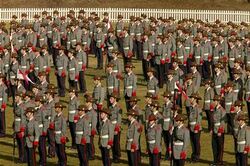
The Cadet Corps is headed by the Sovereign, who holds the title of Captain-General and Admiral of the Corps. Operational command of the entire Corps is held by the Master of Cadets, currently Maj. Gen. Sir Stephen Daldey, who heads the Board of Cadets, a board of the Privy Council. The Corps is divided into the Army Division and Navy Division. The Army Division is organised as if it were a corps of the Royal Army and the Navy Division as a fleet of the Navy Royal. The position of Colonel of Cadets, the head of the Army Division, is held by Col. James Wegg-Wainwright and the position of Commodore of Cadets, the head of the Navy Division, is held by Cdr. Lord Henry de Polstave.[1]
The Corps operate on a practical level more locally within a regional and national hierarchy. Local cadet companies are commanded by adult staff officers, although mostly run by senior cadets. Staff officers of the Corps are commissioned officers in the Home Service or Home Fleet. Army Division units are raised as Companies whilst local units of the Navy Division are known as Training Ships, although the personnel are known as a Ship's Company. The naming convention of units is in the Army Division, 2 Coy. Somewhereton, 1 Ct. Bn. and in the Navy Division, 2 T. S. Someshipname, Somewhereton, 1 Ct. Sqdn.
The majority of units operate in connexion with a particular senior school, although they are not usually school-run programmes per se except for the units raised in independent schools. Navy companies are limited to regions with access either to the coast, or to inland rivers, lakes or meres. Army companies are common throughout the country. A single town often has both Army and Navy companies.
Army Division
Within a company, there are multiple platoons. A platoon is commanded by a senior Under Officer. A Serjeant is the second-in-command of the platoon, with sections commanded by Corporals and Sub-Corporals. Colour Serjeants and Warranted Officers hold appointments within the company, such as Company Serjeant Major and Company Quartermaster Serjeant. Staff Lieutenants and Captains command the company.
Multiple companies are grouped into battalions commanded by a Major. Each battalion operates in a particular region, usually roughly corresponding to a county, although independent and common school companies have their own historical battalions covering a larger area each. A Lieutenant Colonel is in charge of each of the three provincial brigades, somewhat equivalent to a regular Army regiment, and the Colonel of Cadets commands the Army Division. Battalions are numbered sequentially through all three brigades.
Ships' companies have multiple sections each commanded by a senior Under Officer. Within a section the second-in-command is the Petty Officer. Senior Petty Officers and Warranted Officers hold appointments within the company such as Coxswain, Boatswain or Purser. As in army companies, staff Lieutenants and Captains command the entire ship's company.
Several training ships are grouped into a squadron per region commanded by a (Post) Captain. Several squadrons make up each of the three flotillas in the Cadet Fleet, each commanded by a Lieutenant Commander. The Commodore of Cadets commands the Navy Division. Squadrons are numbered sequentially through all three flotillas.
Air Flotilla
A small number of flight companies have been raised in several wealthier common schools. They are raised as a flotilla of the Navy Division, commanded by an Air Captain. There are only two squadrons within the Air Flotilla. Local units are titled Flights, subdivided into Sections.
Instruction and Activities
The cadet curriculum is focussed on military, physical and moral instruction. Instruction and leadership is undertaken principally by senior cadets with some input from adult instructors. Cadet non-commissioned officers are tasked with the instruction and care of their subordinates. Adult officers generally are more focussed on the administrative side of operations. Though there is a clear distinction made between the Army and Navy Divisions, there is no theoretical difference in activities, which are decided upon on a company or platoon level. However, generally, navy cadets have a greater focus on aquatic activities such as rowing, sailing and canoeing, and naval traditions such as signal flags.
However, most cadet activities are based on general outdoormanship or general military training. This includes learning the history, customs and traditions of the military and the Corps, drill, navigation (on land or at sea), field surgery, marksmanship and field-craft or seamanship. Many companies also have bands.
On a moral level, the Corps places emphasis on patriotism and social leadership. Loyalty to God, King and country is paramount, but almost as important is loyalty to one's friends, family and society. A sense of camaraderie and even a level of equality between boys of all backgrounds is promoted, subject to considerations of rank. Public displays of patriotism are encouraged, including the singing of patriotic songs, the use of flags, banners and slogans, community service and respect to authority. Religious observance is also promoted by the Corps, including evening and morning prayers and church parades.
This is combined with a strong emphasis on physical training. Cadets participate in physical training in regular cross-country hikes and marches, rowing voyages, athletics, swimming, gymnastics, wrestling, sports and games. Cadet companies often organise weekends or weeks away in the countryside to participate in training. Each cadet company is expected to run at least one annual week-long field exercise.
On a more frequent level, cadet companies usually have weekly parade nights for formal instruction. Other regular activities are also common, as well as bivouacs over week-ends every term. Formal parades are conducted throughout the year, especially on Whitsunday, Remembrance Day and on St. George's Day (the patron saint of soldiers) or St. Elmo's Day (the patron saint of sailors). Additionally, most companies hold a formal dinner at least thrice annually.
Membership
Membership of the Corps as a cadet is open to boys of good repute between the ages of 11 and 19 inclusive, although the vast majority of boys join before the age of 13. Cadets must be of the Church of Nortend and of satisfactory physical ability. In 2019, there were 620,888 cadets in the Corps and around 20,000 adult officers. Girls may not become cadets.
The vast majority of cadets enter the Corps through their senior school. All boys' state high schools have an associated cadet company. Membership of the Corps is a compulsory at least in the First Form. The vast majority of independent senior schools also have their own cadet companies. 92% of all boys between the ages of 11 and 16 inclusive are or have been active cadets. Even upon leaving senior school after the Fifth Form, many cadets continue their membership in the corps, up until the age of 19.
Approximately 95% of voluntary enlistees in the Royal Army have a background as a cadet NCO or higher. The connexions developed between cadet companies and local regiments and naval bases are considered valuable for recruitment purposes.
Oath
Joining the Corps requires that prospective cadets take the Oath of Engagement in the form prescribed, with [Cadet] replaced as appropriate.
I, A. B., shall be a true and faithful Servant unto His Majesty Our Sovereign Lord as a [Cadet] in His Majesty's Corps of Boy Cadets. So help me God.
Cadet Officers
Cadet senior non-commissioned officers, warranted officers and under officers receive formal training at regional training camps. Though they are guided as to what to teach the cadets under their charge, company and platoon officers have a high degree of freedom and flexibility.
Staff Officers
Staff officers are regularly commissioned officers of the Home Service and Home Fleet respectively, who have been assigned to or have chosen to serve in the Cadet Corps. They are saluted in the normal fashion. The requirement of a university degree for schoolmasters also means many are reserve officers, especially in the Cadet Corps, as muster service for university students is conducted part time during the B. A. degree.
Senior cadets who reached the rank of Warranted Officer or Cadet Under Officer are also usually eligible to train as an officer during their muster service, either at the ordinary Royal Military College, or at their university's Officer Cadet Corps unit. If so, they may be commissioned as reserve officers in the Home reserves and to then serve in the Cadet Corps as staff officers. They are entitled to be immediately promoted to Lieutenant upon leaving muster service.
Staff officers at battalion level and above are employed full time in the Home Service or Fleet.
Remuneration
Cadets do not receive a wage or salary for their membership in the Corps. Companies receive allowances for training, articles of clothing and transport only. Zealous senior cadets may receive stipends similar to adult officer stipends in the Home Service and Home Fleet.
Publications
The Corps produces a monthly magazine, entitled The Boy Cadet which contains news about cadet activities, stories and instruction in all aspects, such as patriotism, military, outdoors and health, as well as general news, politics, history, science, travel reports, reviews, guides, comic strips and advertisements.
It also produces manuals for cadets, such as the Cadet's Service Handbook, which is a large, 400-page manual which is issued to every cadet and details the entire body of practical knowledge a cadet is expected to know, as well as history, regulations and songs.
Ranks
The Corps uses a system of rank analogous to those of the Royal Army and Navy Royal. The prefix Cadet is not normally used internally, except for the ranks of “Cadet” and “Sea Cadet”. There is no equivalent to the rank of Besign or Landman.
Cadet Under Officers receive formal commissions from the War Office entitling them to be saluted by lower ranking cadets only, similar to Cadet Officers. Cadet Warranted Officers also receive warrants of appointment, but they are not thereby entitled to salutes.
Uniforms
The duty uniform of the Army Division is based on the patrol dress of the Royal Army. It includes a khaki-tan shirt with black necktie. This is worn with grey shorts and knee-socks in summer and grey trousers and gaiters in winter, with the black leather belt. A dark khaki-brown coat may be worn over the shirt in winter and cold weather. A grey bonnet or peaked cap is worn.
Navy Division cadets wear a uniform based on the deck dress of the Navy Royal. This comprises a white cotton-linen flannel shirt, a blue jean collar and black neckerchief, with white shorts and navy knee-socks in summer and navy trousers and white gaiters in winter with a white belt. A navy coat may be worn over the shirt and under the collar in winter and cold weather. A navy sailor's cap or sennit hat is worn.
Cadets must wear the uniform of the Corps in accordance with the Corps' uniform regulations. It should not be worn in conjunction with civilian items of clothing, and must be worn at all times at cadet events and activities, unless explicitly dispensed with. Curved royal blue shoulder patches are sewn onto uniform shirts and coats with the words 'Cadet Corps' embroidered in white. A patch lists the battalion or squadron name and number. Shoulder straps list the company and platoon number.
Staff officers wear their corresponding Home Service or Home Fleet uniforms with the cadet shoulder patches.
Dress uniforms
Senior cadets and officers are scaled to receive Dress Order II for day formal occasions as well as mess dress. Individual companies may purchase additional uniform items for junior cadets.
This page is written in Erbonian English, which has its own spelling conventions (colour, travelled, centre, realise, instal, sobre, shew, artefact), and some terms that are used in it may be different or absent from other varieties of English. |
- ↑ By comparison, an Army regiment is headed by an honorary Colonel of the Regiment and commanded by a Lieutenant Colonel. A corps is headed by a Captain-General and commanded by a Colonel.
